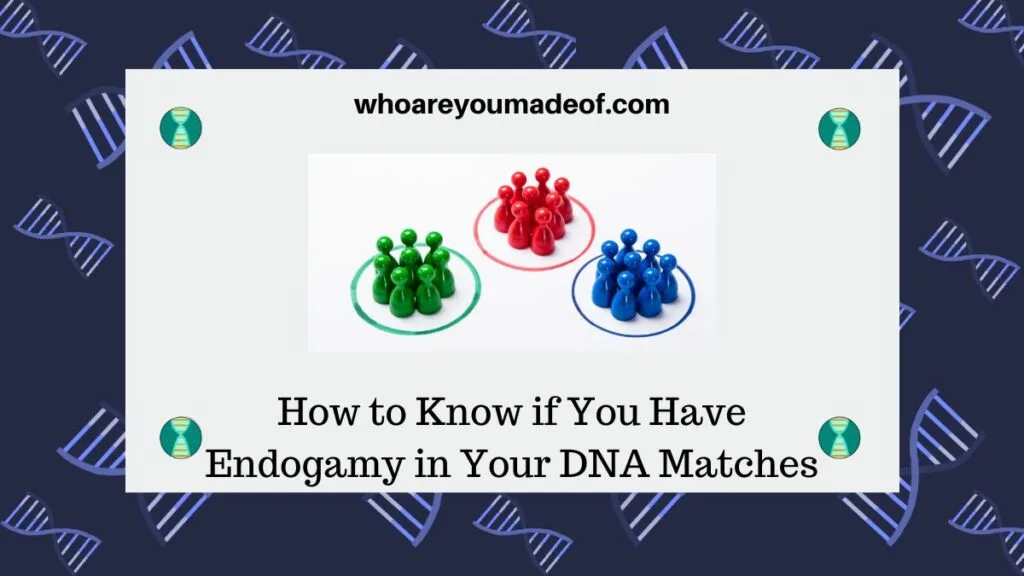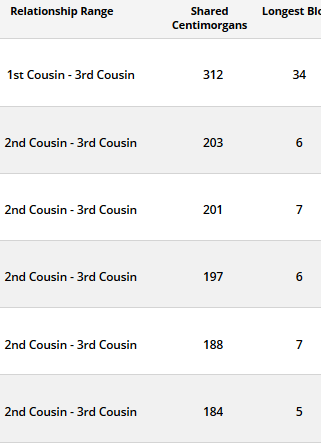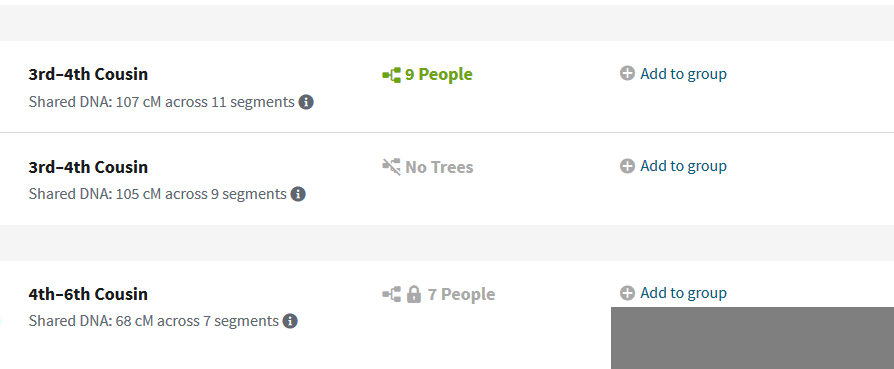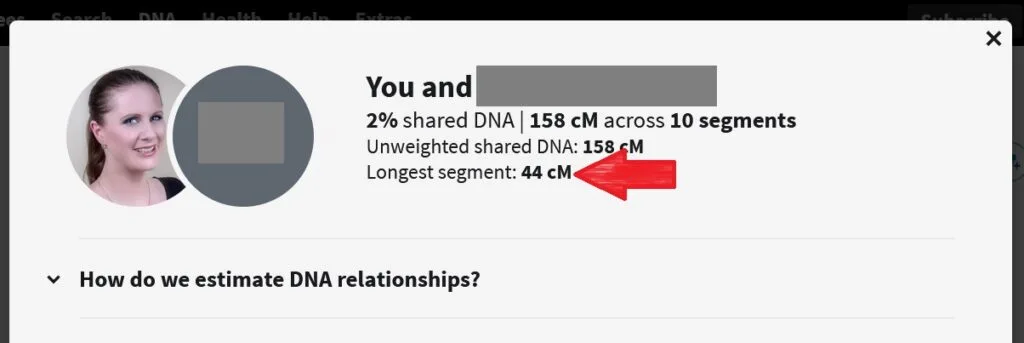Do you want to if you have endogamy in your DNA matches? In this post, learn how to spot it, as well as see examples of endogamy so you can know what to look for in your DNA match list.
In this article, you'll learn:
- A basic definition of endogamy
- How engodamy affects our DNA match list
- Signs that you might have endogamy in your DNA match list
- How to adjust for endogamy in your DNA match list - key for figuring out how you might be related to your endogamous DNA matches

There are several ways that people begin to suspect they might have found evidence of endogamy in their DNA match list. Maybe the shared matches or matches in common seem to overlap multiple lines of the family tree.
Alternatively, we might wonder why we share so many small DNA segments with relatively distant cousins.
If you have spotted these signs, you are correct in thinking about endogamy. Keep reading to learn more about this very interesting topic.
What is endogamy?
The "official" definition of endogamy describes it as the custom of marrying within the same ethnic, social group, or even social class. Many times, endogamy also includes the custom of discouraging marriage to outsiders not a member of the group.
This means that when people are searching for partners or mates within their social or ethnic group, it is likely that their choices for mates share common ancestors with them. After many generations of this practice, it would be difficult to find someone within the group who was not related to you in some way.
Sometimes, endogamy occurs by chance, and not necessarily by choice. Specifically, I'm referring to genetically isolated groups that don't have regular contact with people from other areas.
For example, imagine a group of 100 people who left their original homeland to live on a large island. For our particular example, no one from the outside world has access to the island.
These 100 unrelated people, some men and some women, make their homes on this island and start families. The first few generations of descendants from the original founding group will likely not have endogamy, since the founders were unrelated to each other.
However, since the descendants can only choose mates from other descendants of the original group of founders, eventually they will have to choose someone that they are related to in some way.
It would be easy to imagine that, especially after the passing of many generations, almost all of the youngest generation of children would be related to each other in more than one way.
After many generations, descendants are unlikely to know all of the different ways that they are related to other members of their community.
In other words, there will be many ancestors shared on multiple lines of the family and most people will not be able to identify all of these individuals. They are most likely to know the most recent common ancestor, but not all of the common ancestors.
Here's another example: A few lines of my grandmother's family tree can be traced to Colonial American times. Both of her parents have roots in North America going back as far as the 1600s.
Eventually, we can find evidence that my grandmother's parents likely shared multiple distant ancestors. Their descendants are unaware of this fact.
How engodamy affects our DNA match list
Endogamy can cause distant cousins to share more DNA with each other than is typical among cousins of a particular relationship distance. How does this work?
So, you know those kids on the island that I mentioned? Since they are all related to each other in many ways, they would also likely be DNA matches to each other.
If we gave all of those kids a DNA test, they would all show up on each other's DNA match list.
This might be what you would expect.
Imagine two young residents of this island. They are friends, and they are discussing their families, and after a few minutes, they realize that they share a great-great-great grandmother.
I know it's not super likely that a couple of kids know so much about their family tree, but work with me!
This means that they are fourth cousins.
Fourth cousins who share DNA typically might share as much as 75 centimorgans. These two fourth cousins that I mentioned above might share some DNA that they both inherited from their mutual great-great-great grandmother.
So far, so good - right?
Descendants of endogamous populations are often related to each other in multiple ways
What these two fourth cousins might not know is that they also share a great-great-great grandmother, a set of great-great-great-great grandparents, and even a set of great-great-great-great-great grandparents, all on different lines of their family trees.
Even more interestingly, these fourth cousins might even share additional common ancestors further back - from even before those 100 peoples decided to settle that isolated island. They came from a founding population with similar ancestral roots, so it's quite conceivable.
In other words, these are fourth cousins, but they are also fourth cousins in a different line, fifth cousins, and sixth cousins. Plus, if they are related more distantly (further back than the initial population of that island), they might be eighth cousins, too!
People who are related in more than one way might share more DNA than is typical for their relationship distance
If these two "fourth cousins" took DNA tests, it's possible for them to share DNA that they inherited from all six of their recent common ancestors. And if they did share DNA inherited from all, or some, of those ancestors, there is a good chance that they would share more DNA than 75 centimorgans.
If the DNA test detects substantial DNA inherited from the more recent shared ancestors, and smaller amounts of shared DNA from those distant ancestors, these two friends might show up as having an estimated relationship second-third cousins.
This is because DNA testing companies typically use the total amount of shared DNA to estimate our relationship to our genetic relatives.
Signs that you might have endogamy in your DNA match list
When people with significant endogamy in their family tree look at their DNA match list, they might become confused and frustrated. Their top matches share 100-300 centimorgans with them, which would imply that their most recent common shared ancestors with those matches should only be back a few generations in their family tree.
For example, take a peek at the image below. It's a screenshot of my husband's DNA match list on Family Tree DNA.
I like the Family Tree DNA match list because it's easy to sort and filter the matches, and information like segment size and total shared DNA is easily visible right from this list:

All of the people on this DNA match list share between 184-312 cMs with my husband. In the spirit of full disclosure, I will admit that I was very excited when I first saw this list. Six matches that share more than 184 cMs!
Based on all of the popular DNA charts out there, it is easy to imagine that my husband might share great-great grandparents (at the furthest!) with all of these individuals.
Spoiler alert: None of these individuals, except for the top match, are related to my husband in the past 8+ generations.
Alas, I still had to learn about endogamy.
You might have endogamy in your DNA match list if:
- You have lots of close matches but can't find the connection anywhere
- You are descended from a population that has known endogamy (i.e. genetically isolated populations)
- You share lots of small segments with your matches
- You share a lot of DNA with your matches, but the size of the longest segment is small (more on this below)
It's possible to spot endogamy even on a excellent site like Ancestry DNA (where detailed segment data not available). Take a look at the screenshot from my husband's DNA match list below:

You can see that he shares 107 centimorgans across 11 segments with his top match. While I don't know exactly how big those 11 segments are, I can assume that 11 segments divided into 107 centimorgans will lead to most of those segments being pretty small.
This is unlikely to be a true 3rd-4th cousin match with my husband. Possible, but unlikely.
How to adjust for endogamy in your DNA match list
If you are pretty sure that you are seeing the results of endogamy in your DNA match list, there is one thing that you can focus on to help you get the most from your DNA matches:
- Size of the largest shared DNA segment
As generations pass, the DNA segments that we inherit from our ancestors get smaller and smaller. This also means that larger shared DNA segments with our matches generally indicate a more recent shared ancestor.
There are no hard and fast rules when it comes to the size of DNA segments, but you can use the size of the largest segment to estimate how far back your most recent common ancestor might be.
For example, if the largest segment is 12 cMs in length, it could be from an ancestor as far back as 8 generations (or much further!). If you have a largest segment of 41 cMs, it is very unlikely that the most recent common ancestor is much further back than a great-great grandparent.
On Ancestry, you can't see the size of all of the segments, but you can see the size of the longest segment. You can see this information by clicking on the amount of DNA that you share with your match, upon which time a screen will pop up with additional details about your shared DNA.

In the image above, I note that the largest segment is 44 cMs, which means that we likely share a relatively recent ancestor. While there could be a few endogamous segments among those that I share with this match, I don't think it is likely that this person shows up as a relatively close cousin because of them.
The image below is from my husband's top DNA match. You can see that they share a total of 156 cMs, which would, upon first glance, seem like a close match.

However, we see that they share a whopping 16 segments of DNA and the longest segment is only 15 cMs. If we know that are 15 segments smaller than 15 cMs, we can determine that the rest are likely inherited from many different ancestors - almost definitely a result of endogamy.
It should also be noted that it is possible for some of the smaller shared segments to be inherited from a different ancestor than the one that passed down the largest segment.
Once you have determined a group of DNA matches that seem to be more closely related to you than other, more distant, matches, you can use techniques like the Leeds Method or clustering using custom groups on Ancestry. This may help you determine how some of those DNA matches are related to each other - and you, too.
Conclusion
I hope that this post helped you learn a little bit more about your DNA match list, especially if you have lots of endogamy in your family tree. If you have any questions about something that you read here, I would love to hear from you in the discussion below.
Thanks for stopping by today!


D Gilson
Monday 18th of November 2024
Very good explanation of what endogamy is, does to our shared DNA lists and how to discern if your matches display those properties. Unfortunately though, in your conclusion you mentioned two tools: the Leeds method and auto-clustering which are not helpful or reliable ways to work through to viably process our matches within endogamous communities. We have to utilize other methods, some of which you alluded to (the mathematically based processes that includes analyzing both the number of segments and the largest segments) and constructing trees based on probably generations where the MRCA would be, and so on.
I think it is most important that people always take the predicted range of cousin relationships especially with a shaker full of salt. Also remember that companies like My Heritage further inflates all of our match data (totals, number of segments and largest shared segments including triangulated ones) via their Imputation mechanism, so the reliability of the matches on that platform are even more suspect and cannot be relied on as valid except in closest and known cousins when we hail from endogamous populations.
Linda
Wednesday 20th of December 2023
Hello Mercedes, Please let me try this again. I have a match that is 151 cMs 7 segments 69 longest block. The match is 100% Ashkenazi Jewish, and I am 50%. How close is this relationship to me? Thank you kindly, Linda
D Gilson
Monday 18th of November 2024
Hi @Linda,
While it is not possible to discern with total accuracy what the relativity is - we can do the math in a couple of ways for us to state that this is a match that is in all probability valid (not just random chance, due to endogamy or due to identical by state or population). It is likely viable to find provided you both have constructed family trees that are wide and go as far back as third to fourth great grandparents generations. Since on e of the matches is 50% AJ, you might be able to utilize the Leeds method and auto-clustering tools.
The math for your match: "I have a match that is 151 cMs 7 segments 69 longest block. "
You divide the total shared centimorgans by the number of segments to give us the ratio of 21+ with a ratio of 15 or more usually points to a good sign.
Using the same numbers that you provided, we can also subtract the 69cM largest segment from the total of 151which leaves 82cM to be split amongst the 6 additional segments. That gives you average segments size (outside of the largest one) of approximately 13+ (if one or a few are larger than 13, then others will be smaller).
A shared segment of 62 cM or greater usually (though not always) indicates a relationship of 4th cousin or closer (i.e. a shared ancestral couple at the 3rd great grandparent level). According to the Shared cM Project Tool by Blaine Bettinger, a segment of that size indicates an 85% chance of being a 4th cousin or closer - but that does not take EJ/AJ endogamy into account.
There is no degree of certainty to knowing ahead of time what the relationship is, only what it might be. But that said, if you do the work to build out the trees, it is highly possible for you to discover your mutual MRCA and thus your most recent cousinhood relationship.
Linda
Wednesday 20th of December 2023
I forgot to add 69 block
Linda
Wednesday 20th of December 2023
Hello Mercedes, 151 cMs 7 segments longest block Ashkenazi Jewish they are 100% and I, 50%. How close would this match be to me? Thank You, Linda
Virginia Easley DeMarce
Sunday 10th of December 2023
French-Canadian genealogy is a great place to observe instances of this phenomenon.
Mercedes
Monday 11th of December 2023
Yes, you are absolutely correct - that is a great example!